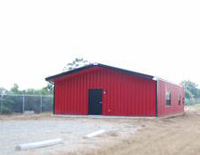The Beck College of Sciences and Mathematics is associated with a wide variety of field stations and research facilities across the region, country, and the world. Some of our affiliated facilities include:
Bearitage Environmental Field Station
Whitehall, AR
 The Bearitage Environmental Field Station was completed in March 2010. The facility is situated on the L'Anguille River, near Whitehall, AR. It sits on a 1,280 acre track of private land owned by Mr. Scott House. Mr. House's resource contributions made the facility construction possible. The structure consists of a 1,200 square feet facility that can house eight. Mr. House has been diligent in efforts to restore the property to a historic state by reconstructing hundreds of acres of wetlands and bottomland hardwood stands. The area is dominated by agriculture production, making Mr. House's island of habitat crucial for many wildlife species.
The Bearitage Environmental Field Station was completed in March 2010. The facility is situated on the L'Anguille River, near Whitehall, AR. It sits on a 1,280 acre track of private land owned by Mr. Scott House. Mr. House's resource contributions made the facility construction possible. The structure consists of a 1,200 square feet facility that can house eight. Mr. House has been diligent in efforts to restore the property to a historic state by reconstructing hundreds of acres of wetlands and bottomland hardwood stands. The area is dominated by agriculture production, making Mr. House's island of habitat crucial for many wildlife species.
Judd Hill Plantation
Poinsett County, AR
In 1985, Ester Hill Chapin established the Judd Hill Foundation for the purpose of research, experimentation and the dissemination of information to the public on progressive techniques in farming. These include activities such as agricultural economics, enhanced seed types, fertilization, irrigation and the control of weeds and pests. Judd Hill is also committed to research in soil and water conservation.
Mammoth Spring National Fish Hatchery
Mammoth Spring, AR
Established in 1903, the Mammoth Spring National Fish Hatchery is located in Mammoth Spring, Arkansas, just across from the Missouri border about 65 miles northwest of Jonesboro, Arkansas. The hatchery is one of the oldest in the United States, and was built in the Ozark foothills in northeast Arkansas due to the availability of cool gravity flow water from the world’s tenth largest spring and easy access to the railroad. Current programs involve the restoration of interjurisdictional fishes (paddlefish and sturgeon); recovery of endangered and threatened species including freshwater mussels; restoration of Gulf Coast Striped Bass populations; restoration of walleye, smallmouth bass and rainbow trout in the White River drainage; and fishery management and stocking recreational fish on national wildlife refuges.
Visit their website >>
USDA-ARS National Sedimentation Laboratory
Oxford, MS
The National Sedimentation Laboratory is comprised of the Watershed Physical Processes Research Unit and the Water Quality and Ecology Research Unit. The National Sedimentation Laboratory (NSL) is one of over one hundred locations of the USDA-Agricultural Research Service (ARS). The program of the NSL is part of the national program of the ARS in natural resources, and it is dedicated to study and find solutions to problems associated with soil erosion and sediment delivery from upland areas, erosion and sedimentation in stream channels, the impact of sediment and other agricultural contaminants on the biological well being of streams, and the loss of nutrients and agricultural chemicals from agricultural activities on the landscape.
Visit their website >>
University of Mississippi Field Station
Oxford, MS
The UM Field Station is a research and educational facility designed to serve visiting faculty and students, public and private schools, government agencies and the broader community of the Mid-South. The Field Station is located on a 740-acre site 11 miles northeast of the UM Oxford campus.
Visit their website >>
National Center for Toxicology Research
Jefferson, AR
The National Center for Toxicological Research (NCTR), FDA's internationally recognized research center, plays a critical role in the FDA’s mission. The unique scientific expertise of NCTR is critical in supporting FDA product centers and their regulatory roles.
Visit their website >>
Center of Quantitative Fisheries Ecology
Norfolk, VA
The Center for Quantitative Fisheries Ecology was conceived by Dr. Cynthia Jones in the 1998 based on her work with the Virginia Marine Resource Commission evaluating fish populations in Chesapeake Bay.
In 2006 CQFE obtained its own building on the campus of Old Dominion University. The building has offices for resident and visiting researchers from around the world, post doctoral fellows and graduate students studying with Dr. Jones, labs for extracting and preparing hard parts (otoliths, scales, opercula, spines), microscopy labs for hard part analysis, and a Class 100 clean room.
Additional Facilities:
- ArCLAS (Arkansas Center for Laser Applications and Science)
- A-State Greenhouse
- A-State Museum
- L.I.T.E.R. (Laboratory for Isotope and Trace Element Research), Norfolk, Virginia







